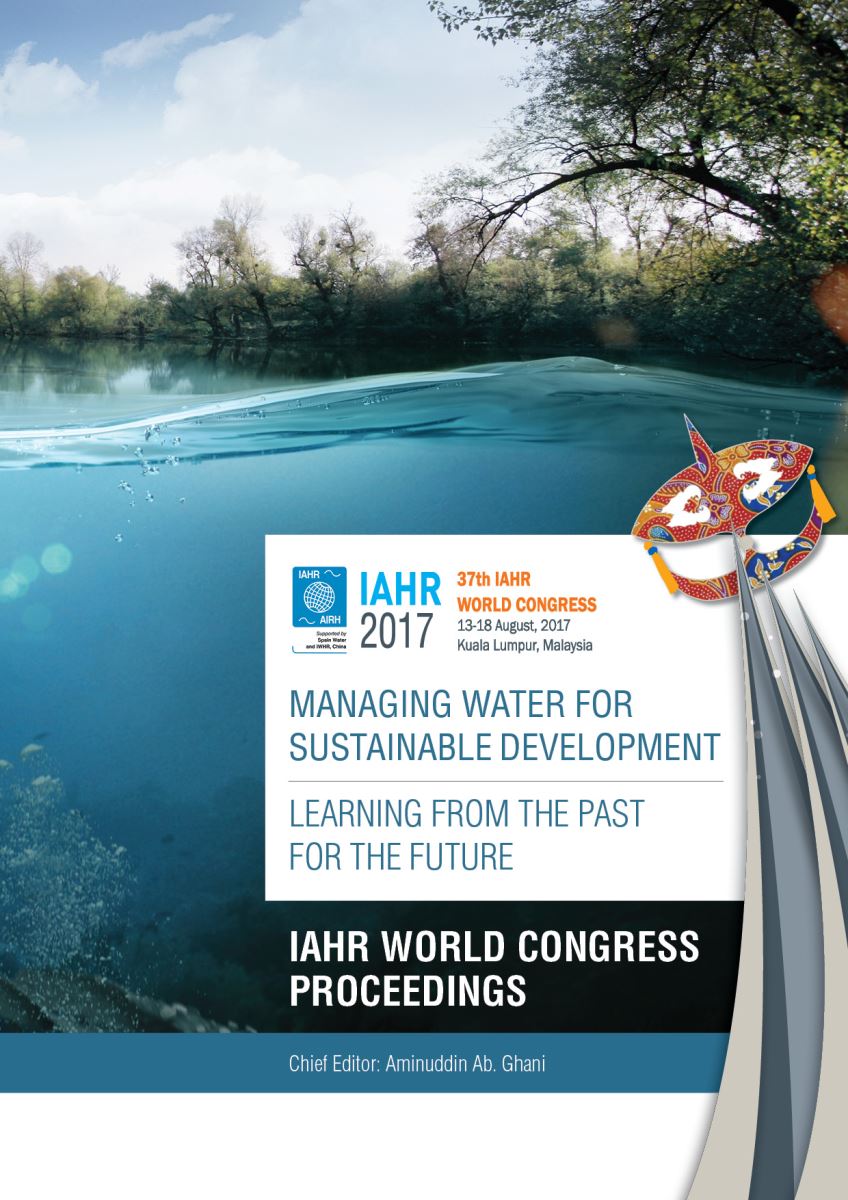IAHR Document Library

Proceedings of the 37th IAHR World Congress (Kuala Lumpur, 2017)
- ISSN Online: 2521-716X
- ISSN Print: 2521-7119
- ISBN:
- Publisher: IAHR & USAINS HOLDING SDN BHD
- Editor(s): Aminuddin Ab. Ghani
- Related: 37th IAHR World Congress (2017, Kuala Lumpur, Malaysia)
Every two years our community gathers together at the IAHR World Congress, and in August 2017 around 1200 participants from 61 countries met at the Putra World Trade Center in Kuala Lumpur, Malaysia. 911 full papers were accepted out of 1324 abstracts submitted. The congress covered seven main themes comprising: River and Sediment Management, Flood Management, Environmental Hydraulics and Industrial Flows, Coastal, Estuaries and Lakes Management, Urban Water Management, Water Resources Management, Hydroinformatics/Computational Methods. Our Congress opened on Monday 14th August by The Honourable Deputy Prime Minister of Malaysia. There were a total of 12 keynotes during the week involving leading specialists in the hydro environment domain from around the world. The Congress closed on the Friday after the Malaysian Deputy Minister for Science, Technology and Innovation gave a highly personal talk about his education, and the differ ences between public perception of water and the environment and that of scientists.
Contents
Cover
Keynote
Theme 1: River and Sediment Management
1a River Conservation and Restoration
1b River Sediment Management and Morphodynamics
1c Debris Flow and Reservoir Sedimentation
1d Flow Interaction With Hydraulic Structure
1e Dam Decommissioning
Theme 2: Flood Management
2a Flood Risk Assessment
2b Urban Flood Management
2c Flood Mitigation and Control
2d Flood Disaster and Adaptation Measures
2e Flood Recovery and Resiliency
Theme 3: Environmental Hydraulics and Industrial Flows
3a Ecohydraulics
3b Sustainable Use of Terrestrial Ecosystem and Rehabilitation of Water Systems
3c Sustainable (Renewable) Energy
3d Industrial Flow Management
3e Hydraulics Machinery
Theme 4: Coastal, Estuaries and Lakes Management
4a Coastal and Estuary Morphodynamics
4b Estuaries and Shore Protection
4c Dynamics and Exchanges in Estuary-Coastal Zone
4d Inland and Coastal Lake Management
4e Coastal Structures (Ports and Harbours)
Theme 5: Urban Water Management
5a Rainfall-Runoff Processes and Modelling
5b Assessment of Stormwater and Cso Quality and Its Impacts
5c Sewer Sediment
5d Stormwater Management
5e Combined Sewer Overflow (Cso) Control
Theme 6: Water Resources Management
6a Water Resources Management Under Increasing Uncertainty
6b Alternative Water Resources
6c Conflict Resolution in Water Management
6d Advanced Water Resources Systems Analyses
6e Groundwater Hydraulics
Theme 7: Hydroinformatics/Computational Methods and Experimental
7a High Performance Computing and 5th Generation of Modelling Systems
7b Impacts of Pollutants on the Environment
7c Development and Application of Soft Computing Tools in Hydroinformatics
7d Instrumentation and Experimental Methods
7e Big Data and Data Acquisition Technologies
Special Session
SS 1 Transients in Pipes
SS 2 Sustainable Water Resources Planning & Management Under Climate Change
SS 3 Green Infra as Disaster Risk Reduction Measures in the Asian-Pacific Region
SS 4 the Path to Resiliency in Low Gradient Coastal Regions for Present and Future Conditions
SS 5 Function of Governance to River Restoration Under the Climate Change
SS 6 Coastal Reservoir - a Technology That Can Develop Freshwater From the Sea Without Desalination
Review Process
The papers included in this volume were part of the 37th IAHR World Congress cited on the cover and title page. Papers were selected and subjected to review by the Editor and the International Scientific Committee and followed a revision process with the following steps: First, several of the committees involved in the organization of the congress established a set of technical criteria for the Committee in charge of the revision. Submitted papers were sent to one or two experts in the field. Authors were then asked to include the necessary amendments and follow the reviewers' comments, and their work was reviewed until the final version was approved by the Editor.
Ethical guidelines and Code of Conduct
In addition to the technical criteria, IAHR publications follow the Ethical Guidelines and Code of Conduct provided by the Committee of Publication Ethics (COPE). A Publication Ethics and a Publication Malpractice statement are publicly available throughout the entire review process.
The 37th IAHR World Congress proceedings are long-term preserved following the IAHR Policy of digital preservation archives.
| ID | Title | Authors | Year |
|---|---|---|---|
| 2582 | Direct Debris Flow Monitoring Using Load Cell Systems in Sakurajima Island |
Takahiro Itoh, Takahisa Mizuyama, Satoshi Tagata
|
2017 |
| 2583 | Debris and Mudflow Computer Model |
Norlida Mohd Dom, Sandra Ligong, A. Razak Baharom
|
2017 |
| 2584 | Numerical Simulation of Flow and Sediment Transport in Tanks With the Influence of Cavity |
Abdellah Ghenaim, Yi Liu, Abdelali Terfous, Pierre-Andre Garambois
|
2017 |
| 2585 | Iinfluence of the Upper Yangtze River Sediment Decreasing on Sedimentation in Three Gorges Reservoir |
Wenjie Li, Shengfa Yang, Pingyi Wang, Yi Xiao, Jiang Hu, Xuhui Fu
|
2017 |
| 2586 | Scour Morphology Due to Vertical Crossing Jets With Different Diameters |
Michele Palermo, Stefano Pagliara
|
2017 |
| 2587 | Flow Behavior Over Ogee and Stepped Spillway Under Different Flow Conditions: An Empirical Approach |
Sumit Gandhi, Kirtika Sachdeva, Mudit Khandelwal, Rajesh Rai, Vikram Singh, Sudeep Srivastava, Surya Pratap Meena
|
2017 |
| 2588 | Scour Around Bridge Abutments Under Unsteady Flows |
Jian Hao Hong, Rajkumar V. Raikar, Anand R. Deshmukh, Wen Dar Guo
|
2017 |
| 2589 | Numerical Investigation of Step Dimensions Impact Over Gabion Stepped Spillways |
Ali Adel Zuhaira, Harshinie Karunarathna, Dominic E. Reeve
|
2017 |
| 2590 | Application of Rng K-E Turbulence Model to Supercritical Bend Flow |
Bo Wang, Yunliang Chen, Chao Wu, Xiao Ma, Jiajun Song, Zhong Tian
|
2017 |
| 2591 | Critical Submergence for Water Intakes |
Muhammed Hashid, Zulfequar Ahmad
|
2017 |